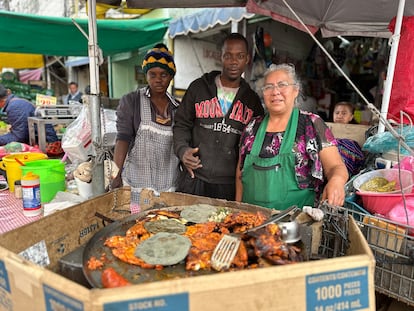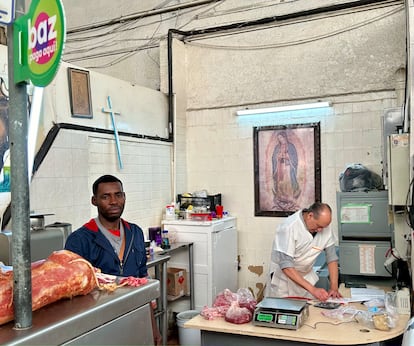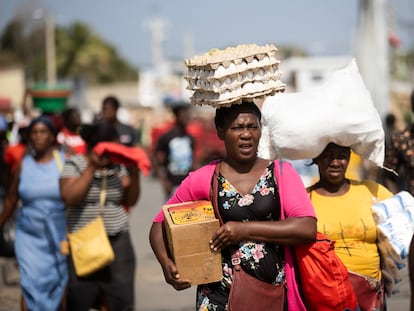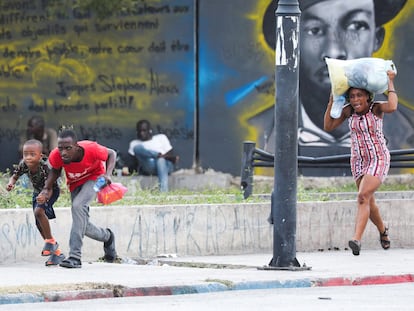Work and peace: A growing number of Haitians, dreaming of a better future, make their home in Mexico City
More than 44,000 refugees from the Caribbean country requested asylum in Mexico in 2023. Many of them have found employment in the food industry and in the large markets of the capital

“C’mon, let’s go for the next one!” Ralph Sunday — a vigorous 18-year-old Haitian man — encourages his companions in Spanish. It’s seven in the morning: the cold of Mexico City isn’t mitigated by the timid rise of the winter sun. Since five o’clock, this Caribbean migrant and his three Mexican colleagues have been hard at work, loading and unloading trailers that transport fruits and vegetables from all corners of the country to the largest wholesale food market in the world: the Central de Abasto, in Mexico City.
Opened in 1982 and located in the extreme east of the North American city, La Central — as it’s commonly known — stores approximately 122,000 tons of fresh produce, including corn, tomatoes, sesame seeds, beans, turkey, pork, shrimp, pineapple, tejocote, chili, jicama, tamarind, mango, and sapodilla. The market feeds the nearly 22 million inhabitants of the Anáhuac Valley on a daily basis, employing more than 70,000 people. Among them are an increasingly notable number of Haitians.
“We’ve never seen this before — and I’ve been working here all my life,” says Eduardo Gómez, an 84-year-old merchant, who has spent more than 60 years dedicated to the buying and selling of food, at both wholesale and retail prices. He’s referring to the presence of dozens of migrants and asylum seekers of Haitian origin. These men and women work as forklift drivers and loaders, but also as dispatchers and clerks in the numerous warehouses and in the endless corridors of the Central de Abasto. But not only there: recently-arrived Haitian immigrants have found work in flea markets, grocery stores and food trucks across the city.

“I mop up, I help keep the premises clean. I assist in refrigerating, storing and packaging the meat. Sometimes, I also help serve the customers,” explains France Nore, when asked about his responsibilities at the meat-and-sausage stand that Mario Zamora has run for 50 years in the Benito Juárez Market. The 34-year-old immigrant hails from the Haitian town of Les Cayes, in the south of the Caribbean island nation. Three months ago, he arrived in Tapachula — in the Mexican state of Chiapas — and subsequently moved to the capital.
Before he arrived in this country, Nore made a journey that lasted several weeks at a cost of $3,800, which he had to pay to coyotes (human-traffickers), organized criminal groups, police officers and immigration officials. He had to take a plane from Port-au-Prince to Managua, Nicaragua, followed by a trip by bus and by foot through Honduras, El Salvador and Guatemala, until he finally reached the Mexican border.
Between January and December 2023, Mexico received 140,982 asylum requests from nationals of 20 countries, according to statistics from the Mexican Commission for Refugee Assistance (COMAR), the entity in charge of processing asylum and refuge requests. Haiti was the country with the highest number of applications: 44,239.
Experts in human migration and refugee studies point out that the economic, social, political and climatic conditions that affect the Caribbean nation have contributed to this migration. Haiti has a chronic institutional weakness as a result of continued political crises, increases in violence and crime, as well as high unemployment. A weak economy and high vulnerability to natural disasters has long made Haitian emigration a phenomenon that is difficult to halt.
“There are no jobs, we don’t have a president, nor do we have peace. What else can we do other than get out of there?” laments Edith Ossias, 35, while telling EL PAÍS about the reasons why she left her native Cap-Haïtien to settle in Mexico City. Here, she works part-time in Mrs. Chole’s streetside kitchen, inside the cavernous La Merced market, a concrete hulk embedded in the city. It was declared a world heritage site by UNESCO in 1987. This is the same market where, in the late-19th and early-20th century, thousands of Spanish, Jewish and Lebanese migrants arrived to work and make a living. Haitians are doing the same today, with Cubans and Venezuelans following suit, albeit to a lesser extent.
Located in the neighborhood of the same name — at the crossroads of iconic avenues such as Paseo de la Reforma, Chapultepec and Insurgentes — the Benito Juárez Market serves both middle-class Mexicans who live nearby as well as digital nomads from the United States or Canada. They’ve settled in this area since the pandemic, in the nearby, expensive and famous neighborhoods of Roma and Condesa. In its hallways and stalls, amidst piñatas, fresh cheese, handmade corn tortillas, mole, pulque and mezcal, a dozen Haitians tell stories — in Spanish, Creole and French — that are tragically similar.
“My dream is to be able to save enough to practice my profession as an electrician, set up a small business, spend more time here in Mexico and bring my family,” confesses Mackinson Joseph, 28, as he finishes his shift. He earns the equivalent of $25 a day for cleaning and wrapping potatoes in one of the many bodegas that populate La Central.
“Haitians are very resilient,” says Andrés Ramírez, coordinator of the Mexican Commission for Refugee Assistance. “They can adapt to Mexican society, despite coming from a very different culture.”
Mackinson Joseph is proof of this. Between laughter and gestures of complicity, he makes jokes in slang with his three Mexican colleagues. They work together 12 hours a day, Monday through Sunday, surrounded by stacks of potatoes. Like them, he also calls the capital city home.
Translated by Avik Jain Chatlani.
Sign up for our weekly newsletter to get more English-language news coverage from EL PAÍS USA Edition
Tu suscripción se está usando en otro dispositivo
¿Quieres añadir otro usuario a tu suscripción?
Si continúas leyendo en este dispositivo, no se podrá leer en el otro.
FlechaTu suscripción se está usando en otro dispositivo y solo puedes acceder a EL PAÍS desde un dispositivo a la vez.
Si quieres compartir tu cuenta, cambia tu suscripción a la modalidad Premium, así podrás añadir otro usuario. Cada uno accederá con su propia cuenta de email, lo que os permitirá personalizar vuestra experiencia en EL PAÍS.
¿Tienes una suscripción de empresa? Accede aquí para contratar más cuentas.
En el caso de no saber quién está usando tu cuenta, te recomendamos cambiar tu contraseña aquí.
Si decides continuar compartiendo tu cuenta, este mensaje se mostrará en tu dispositivo y en el de la otra persona que está usando tu cuenta de forma indefinida, afectando a tu experiencia de lectura. Puedes consultar aquí los términos y condiciones de la suscripción digital.
More information
Archived In
Últimas noticias
Most viewed
- Sinaloa Cartel war is taking its toll on Los Chapitos
- Oona Chaplin: ‘I told James Cameron that I was living in a treehouse and starting a permaculture project with a friend’
- Reinhard Genzel, Nobel laureate in physics: ‘One-minute videos will never give you the truth’
- Why the price of coffee has skyrocketed: from Brazilian plantations to specialty coffee houses
- Silver prices are going crazy: This is what’s fueling the rally










































